Andrea Downing's Blog, page 12
June 15, 2015
PIGLETS AND BAIL BOND
On a day when we’ve driven 310 miles, there are no pretty pictures to share. Our aim was to get to Charlotte, NC, from whence I write, preceded by a visit to antique shops and a furniture outlet mall in the search for furnishings for Cristal’s newly renovated apartment. We’ve been successful in getting her a new mattress for her new bed, and extremely efficient in tiring ourselves just enough to enjoy a superlative dinner and bottle of wine. Lunch, however, was literally on the hoof. At a farmer’s market in some unknown town off the highway, we bought bread, cheese and fresh blackberries to gobble in a car whose temperature must have been in the high 90s. The bulletin board in the market advertised piglets, guinea hens, and chickens for sale, along with Bail Bond and Auto Body Repairs. This last did not imbue me with a great deal of confidence in my fellow drivers on the North Carolina highways…but we are safe in Charlotte


June 14, 2015
NO WALTONS HERE
 Say the words Shenandoah or Blue Ridge Mountains to me and it would previously conjure up the Waltons, folk songs and early Americana. But while Skyline Drive and the Shenandoah National Park certainly take you away from the rush of modern city life, somehow the mere fact that it is a car drive as well as hikes that bring people here to cool off in the mountains, misplaces the thought of racoon hunting or dueling banjos. Escape yes, Waltons no.
Say the words Shenandoah or Blue Ridge Mountains to me and it would previously conjure up the Waltons, folk songs and early Americana. But while Skyline Drive and the Shenandoah National Park certainly take you away from the rush of modern city life, somehow the mere fact that it is a car drive as well as hikes that bring people here to cool off in the mountains, misplaces the thought of racoon hunting or dueling banjos. Escape yes, Waltons no.
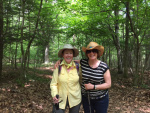
Linda on L and I
My friend and fellow author, as well as naturalist and artist, Linda Johnston, drove nearly two hours to take Cristal and I on a great hike, gab and catch up. Linda, I’m going to try to remember what Mountain Laurel looks like.

Mountain Laurel
And goodnight, John-Boy…


June 13, 2015
BLUE PAINTED HILLS
Gettysburg Battlefield
First let me say that if you go to Gettysburg, please allow a full day; don’t try to fit it in en route as we did. The car tour alone, around the 24 miles of sites, takes 3 hours. But I digress…what I want to say is that a visit to Gettysburg is a brain full of ‘What if”s: What if Lincoln hadn’t been elected? What if the South hadn’t seceded? What if the South had won?
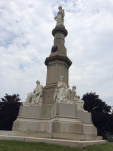
Memorial on the spot of Lincoln’s address
What if Lincoln hadn’t signed an Emancipation Proclamation? Well, by now of course, there would have been a slave rebellion at least, but what if the South had been a separate country?
Luckily for us, it is not. The Union Army painted those hills blue and now I have got to Shenandoah National Park in the Blue Ridge Mountains of Virginia without having to use a passport. Thanks, Abe!
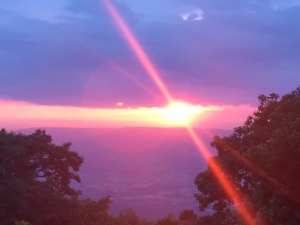
Sunset at Shenandoah


June 12, 2015
Voyeurism in Intercourse
Well, that got your attention. But Intercourse is a town, an Amish one at that. It’s difficult to sum up what it’s like to visit a sect of people just to see the way they live, a Disneyland of sorts, or a film set, complete with costumes and horse drawn buggies. The beautifully kept farms and homes give way to a sad display of crafts now catering mostly to tourists: woodwork and quilting plus the understandable farm goods. You do end up feeling like a voyeur, while non-Amish locals tend to the passing trade by selling ‘Whoopie Pies’ in Intercourse.
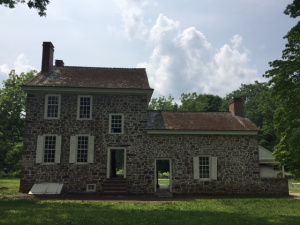
General Washington’s Headquarters at Valley Forge
Far more interesting was Valley Forge. Temperatures in the 90s did not dull my sense of history, further enhanced by storytellers Phil

Storyteller Phil
and Claire, as well as tour guide Doug, who brought to life what it was like to survive the encampment at Valley Forge. Our intended 4 mile hike out the window due to the heat, we took a trolley ride which included Washington’s Headquarters. My sense of history, of the men who fought for the liberties we enjoy today, is most likely met by those who continue to fight for our liberty and are camped at Valley Forge prior to their time in Iraq.
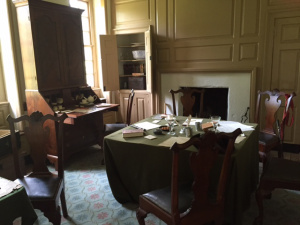
General Washington’s Office at Valley Forge


June 11, 2015
TWO FOR THE ROAD/
DAY 1/282 MILES/454 KM  When I was a young child, road-trips with my parents always seemed to start on the New Jersey Turnpike. Those trips basically consisted of overcoming shortcomings with our family car—a radiator that invariably overheated, as well as suspension that made me carsick—and being amused by Burma Shave signs. They also entailed lunch stops at Howard Johnson’s restaurant, which meant, for me, a desert of hot fudge sauce on ice cream roll.
When I was a young child, road-trips with my parents always seemed to start on the New Jersey Turnpike. Those trips basically consisted of overcoming shortcomings with our family car—a radiator that invariably overheated, as well as suspension that made me carsick—and being amused by Burma Shave signs. They also entailed lunch stops at Howard Johnson’s restaurant, which meant, for me, a desert of hot fudge sauce on ice cream roll.
Today’s first day, driving to Lancaster, PA, home of the Amish community in the US, involved nothing like that. What was once green belt around the turnpike with views of farmland has turned into one huge conurbation that stretches almost into the confines of the Amish farming community. And as the grey of threatening weather added little to the sense of getting out into the country, I could not lose the feeling that time and man had encroached on something once charming.

Cristal moving luggage
Having said that, I am happy to be here in Lancaster, PA, on the first day of our trip. The day went without mishap and had a number of laughs—not least of which was us trying to get our seven weeks of luggage up to our room. We just were too elated not to have the restrictions of an airline. Added to that is the wonder that a sect of people can maintain their own restrictions on
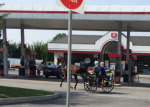
A fill-up at the pumps?
lifestyle in this day and age. But more on that later…


June 1, 2015
ROAD-TRIP 2015 #XCOUNTRY2015
Road-trip! The very word conjures up America, the length of open highway pulling you forward across an expanse of continent yet to be explored. Ever since Dennis Hopper and Peter Fonda hit the road in Easy Rider in, yes, 1969, the quintessential American vacation has been a road trip. Open road, open mind.
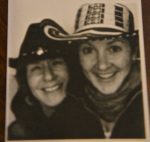
Cristal & I taken at the famous Wall Pharmacy outside Badlands NP
My daughter, Cristal, and I have taken several of these jaunts since my return to live in the USA in 2008. While the jokes about Thelma and Louise are wearing thin, the pure joy of anticipation has not. In the past, we have flown somewhere and gone on through several states in a rental car. Our first expedition of this nature was probably eventful enough to put most people off from ever venturing forth again. May, 2011, followed a winter that refused to give up and had dumped over 450 inches of snow in parts of the northwest. But we had plans… We viewed Mt. Rushmore through flurrying flakes and headed down to Badlands National Park

At Badlands Nat’l Pk., SD
as intended. While daytime walks were manageable, nighttime temperatures were not. At twenty-one degrees, stuck in a cabin with a rattling heater that refused to fulfill its purpose, we had to double up with the blankets from both beds and joint body heat in order to stay warm. Since the park restaurant closed at 4pm, we struggled to survive on packet tuna, protein bars and crisps. Our intended journey up through Montana had to be ditched due to closed roads, but we managed to visit Jackson, WY, collecting a speeding ticket in Dubois en route, and head on to Moab, UT, down to Durango, CO, and have a grand finale in Taos and Santa Fe, NM.

In San Francisco
Undaunted, the next year we planned a four week trip extending from San Francisco to Glacier National Park. Unfortunately, Cristal, who now works for the UN, was selected to give two papers at a conference back in NYC on Global Security and Human Rights. I saw this as a chance to do the wash and re-pack at the two week mark. It therefore became two road trips, if you like: San Francisco to Salt Lake City, including a stay on a working cattle ranch down forty miles of dirt road and seventy miles from the nearest town. Then, Jackson to Glacier. We are obviously hooked!
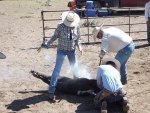
Branding at Cottonwood Ranch, NV
As Cristal prepares to leave her tenure with the UN in Bogota, Colombia, and faces shorter vacations in a new position, not to mention a boyfriend of three years claiming more of her time, we have planned a possibly last, great road trip for 2015—and, believe me, it has been long in the planning. So often we have talked about travelling right across the United States, we decided to finally make it a reality. Growing up, Cristal kept a map of the U.S. and put stars on each state she had visited. It was something like twenty-seven at last count; as for myself, being somewhat more than twice her age, it was a few more than that (approx. 33 states). We hope to add to our list. Therefore, on June 11th, 2015, we head from East Hampton, NY—some 110 miles east of NYC—right across to Jackson, WY, before heading back via a different route. For this we have allocated seven weeks and have saved for several years.

Cristal at Canyonlands NP, UTah
What are the preparations for such a trip? Well, first of all, four new tires top the list as well as a full batch of all the various liquids a car takes and a tune-up to make it sing. Because this trip is in June and July, the height of the vacation period, reservations were necessary well in advance. As it was, we could not get the rooms in Yellowstone we wanted at the time we booked—about six months in advance. Yes, advance planning is a must, albeit difficult. Lists! We have lists of restaurants we want to dine in (being foodies of some nature), activities we want to take part in—especially running, as Cristal prepares for a half-marathon—and friends with whom we want to touch base. We know the distances and driving times between stops, and I’ve got a fine collection of brochures from tourist boards throughout the country. If you feel all this lacks a certain amount of spontaneity, let me just say that at my grand old age I do not wish to anticipate a night spent sleeping in my car due to a lack of motel reservation, nor do I wish to drive through X-place and later discover they were having a —– I missed. Hence, rodeo tickets, lake cruises, float trips, horse-back riding, ferries and so on have been booked. Rendezvous with several friends along the route have been confirmed. Packing lists have been coordinated. A small shopping list of provisions to have on hand has been prepared: water, snacks and various components of a smoothie breakfast. Yes, we have purchased a small blender of the bullet variety to take along. We’re an organized duo!
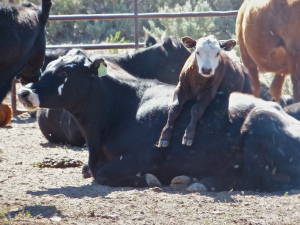
At Cottonwood Ranch
There have also been many things at home to organize: holding the mail, making sure all bills reach me via internet or are paid in advance, scheduling appointments for our return. Most of all, I have to face up to my fears. Will we get a flat tire on some godforsaken road, will a tire off an 18-wheeler come flying through our windshield, or perhaps some loose load in a pick-up truck? Will our car be robbed or will we be pickpocketed, shot perhaps while we innocently munch lunch? Will a tornado come roaring toward us with no shelter in sight? Or, will I become ill in a distant town?
The one sad thing about a trip of this nature is that, yes, it is a taster trip. We cannot spend a great deal of time in any one location; it is just not possible. Therefore, it is a trip of highlights, of overnights or two nights here, three nights there, until we reach Jackson , WY, which is out rest and turn-around spot. The outward itinerary takes us from New York through PA, NC, TN, MO, KS, CO and WY. On the journey home we venture into ND, MN and then into Canada before winding down and back home through NY. Please cheer us on and, if by chance you happen to live in one of those places, keep an eye out for us. I shall be posting almost daily—as internet access permits—via Facebook https://www.facebook.com/writerAndreaDowning or https://www.facebook.com/andrea.downing.5, on Twitter @AndiDowning and, most especially, right here at http://andreadowning.com


May 6, 2015
THE OLDEST RANCH IN AMERICA
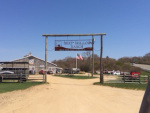 When you say the word ‘ranch’ you generally think of the west with its wide open spaces and endless plains. You certainly don’t think of the east coast, and much less likely the east end of Long Island, an area generally associated with coastal resort living and fishermen. But that is exactly where the oldest ranch in America is found—at the very tip of Long Island, 118 miles east of NYC, in the village of Montauk…right down the road from me.
When you say the word ‘ranch’ you generally think of the west with its wide open spaces and endless plains. You certainly don’t think of the east coast, and much less likely the east end of Long Island, an area generally associated with coastal resort living and fishermen. But that is exactly where the oldest ranch in America is found—at the very tip of Long Island, 118 miles east of NYC, in the village of Montauk…right down the road from me.
To be fair, ‘oldest ranch’ might be a stretch. In 1658, the year Deep Hollow Ranch claims to have been established, the land was used for pasturage of cattle, and certainly in that way it has been in continual use. At that time, the pastures were leased for grazing from the Montaukett Indians. There is an earmark register with the Town Clerk here in East Hampton (of which town Montauk village is a part) that goes all the way back to the 1660s. Up until around 1700, the value of two cows was equal to a small house, so this source of wealth had to be protected. With this in mind, by 1747, three houses were built on the road from East
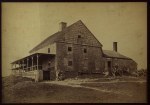
Third House, courtesy Long Island Collection, East Hampton Library
Hampton village, where most of the settlers actually lived. These residences were to accommodate travelers and the keepers, men of prominent families who could ensure the integrity of the shared pasture. The houses were numbered according to the order one passed them on the road from the west. Third House eventually became Deep Hollow Ranch.
While the First House keeper was responsible for entering all the cattle in the common pasture on a list and repairing fences, and Second House was responsible for sheep, it was left to the Third House Keeper to have a list of all stock kept on the fatting field, which is now the land around Deep Hollow. He had to ride out Tuesdays and Fridays to check on the cattle, and the great June round-up was also held at Third House. The first cowboy? The Town Trustees fixed the number of cattle permitted on the pasture according to the condition of the grass, with one horse equaling two head of cattle, and one beast equaling seven sheep. Eventually, as many as 6,000 head of cattle, horses and sheep grazed this fourteen mile stretch between East Hampton and Montauk, May through November; they came from
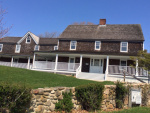
Third House today
as far as seventy miles away. If a landowner did not use his full allowance, he was permitted to rent out his share of the pasturage. In winter, the cattle would be driven back to the individual farms on a date fixed by the Town Council. If the weather held, this could be as late as December, and Thanksgiving, at a time when it was still a moveable feast, was not held locally until after the cattle drive.
During the Revolution, the British sailed in to replenish their supplies. Some 2,000 cattle were removed to safety while 3,000 sheep remained. One hundred and forty men came to protect the livestock, and stood on a hilltop where they could clearly be seen by the British in their ship. They repeatedly turned their coats several times to fool the enemy into thinking there were more men than sheep. Hence, ‘turncoats.’ While the British left on that occasion, residents were less lucky in the War of 1812 when the English came ashore.
Third House burnt down in 1806 and was rebuilt, being restored once more in the 1950s. In 1879, Arthur Benson bought 10,000 acres for $151,000 and proceeded to make Third House his residence, building an extension. His idea was to force the Montaukett off the land and make the area into a resort. But at a time when it took some six hours to travel the distance from East Hampton alone, riding through mosquito and fly infested dunes, the idea never took off. In 1895, the Long Island Railway was extended into Montauk with the thought that it might become a major seaport, easing the port of New York.
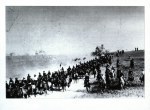
Teddy Roosevelt (lower right) & Rough Riders at Camp Wikoff, 1898–courtesy C. Frank Dayton collection, East Hampton Library
The seaport never developed but the railway reduced the cattle drive to the pasture. Benson’s heirs sold off his land, mostly to the federal government for various service bases. In 1898, when Teddy Roosevelt returned after the Spanish American War, the land was used to accommodate more than 29,000 men. It was then called Camp Wikoff, and Third House was TR’s office. The Rough Riders were eventually disbanded here.
In the 1920s, Benson’s heirs sold more land to entrepreneur Carl Fisher. ‘Mr. Miami’ envisaged a Miami of the north, and Indian Field, the main field across from Third House, became a polo field for a time. Fisher was impeded by the LI State Park Commission seizing nearly 2,000 acres by eminent domain in 1924, and he later lost his fortune in the 1929 stock market crash. Eventually, in 1936, a very young Phineas Dickinson III leased the land with the help of his family and brought in 150 head of cattle. Deep Hollow Ranch became a cattle and guest ranch—and at times cocktail lounge and restaurant—
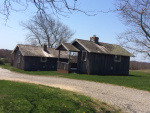
The cottages today
and in October a hunting lodge, with the exception of the WWII years. Dickinson contacted Texas ranches to supply his cattle, and for ten years this went on with the cattle being shipped by rail followed by a four mile cattle drive from the station to the ranch. The West had come east.
Deep Hollow Guest and Cattle Ranch passed through several hands over the ensuing years. A brochure I have advertises ranch rides, moonlight rides and range riding as well as archery, deep sea fishing, golf, hunting, swimming and tennis—not all of it on the premises, of course. I see advice on what to wear and “Trained cowboys will
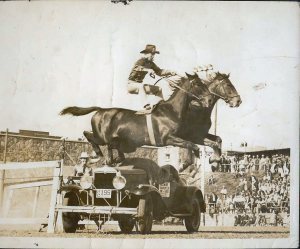
Entertainment at Deep Hollow Ranch, courtesy Montauk Library
instruct the novices in riding ranger fashion, roping and even ‘bull-dogging’” In the 1930s, the rate for a two bedroom private cottage with meals was $104 weekly!
Since that time, the approximately 1,157 acres around Third House, including Indian Fields, have gone through various permutations as first Indian Field County Park, Montauk County Park and Theodore Roosevelt County Park. In 1971, nineteen year old Randy Leaver, a former ranch hand at Deep Hollow, bought the
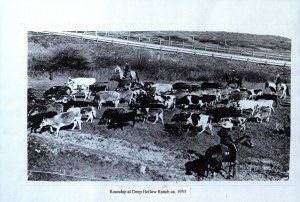
Round-up at Deep Hollow, ca. 1955 courtesy Shank Dickinson Collection in the LI Collection, East Hampton Library
concession to the ranch, which now sits in the county park. Married to one of the Dickinson daughters, he developed the ranch pretty much as it is today. He brought in fifty head of Black Angus cattle and leased another 4,000 acres for trail riding through the dunes. Chuckwagon rides and Texas BBQs became part of the attraction, as did rodeos—
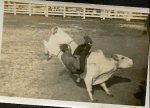
courtesy Montauk Library
fighting local ignorance about ‘animal cruelty’ in such events. The Leavers also instituted Back at the Ranch benefit concerts with the help of neighbor Paul Simon. These went on for many years with notaries such as Jimmy Buffett, Billy Joel and The Highwaymen as attractions.
Just as western ranchers have land disputes and upsets with the BLM and other government bodies, so Leaver had a dispute with the local Board in the early 2000s. Saying he was spending more on lawyers than on the ranch, he eventually decided to retire
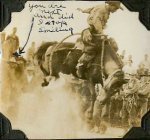
Deep Hollow Ranch, Postcard collection, courtesy Montauk Library
and passed on the concession five years ago to its present managers, Pat and Cate Keogh. Cate is a local Montauk gal while Pat is purebred Colorado cowboy and rodeo star. The Keoghs run Corriente/Longhorn cattle and train cutting horses, in addition to managing the ranch. Wagon and trail rides through the dunes are supplemented by a pony camp in the summer and Native American presentations for schoolchildren. While they live a short distance down the road with their three children, they are hoping to expand the ranch with a Center for Wildlife Rescue, and renovations to the old cabins and Third House for future guest use. It looks as if Deep Hollow Ranch is set for quite some time to come.
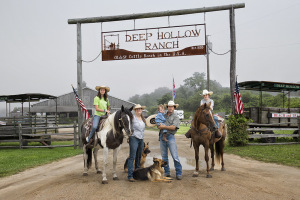
The Keogh Family, courtesy Cate Keogh
My sincere thanks to Robin Strong, Archivist at Montauk Library, for her help and guidance in the research for this article. I would also like to thank Steve Russell Boerner and Andrea Meyer, Librarians and Archivists, for their help and guidance at East Hampton Library. Finally, my thanks to Cate Keogh for taking the time to show me around Deep Hollow Ranch and share its history with me.
There is one rather unpleasant footnote to this story. While researching in Montauk Library, Archivist Robin Strong pointed out to me a stamped sentence at the bottom of the 1930s ranch brochure: “The clientele is restricted to Gentiles” She was as amazed and disgusted as I at such blatant anti-Semitism. Happily, such restrictions are long gone.


April 7, 2015
FORGOTTEN FACTS
We’ve often talked on these pages about the shifting sands of history, the kaleidoscopic view of past events. Differing opinions, new information come to light, changes in attitudes—all these can make small aftershocks in the picture of an historical event. But what about those facts that are gently sidelined from the viewing stand? The information that is there, uncovered, but, for whatever reason, never discussed? Here are nine facts your history teacher may have glossed over.

Christopher Columbus
Ever wonder why our continent in the New World is called America and not Colombia? All right, we know America was named after Amerigo Vespucci: but why? Authors like myself know quite a bit about the necessity of promotion and, in that way, times have not changed. While Columbus continued to sail the ocean blue and thence out of his contemporaries thoughts, letters from Amerigo Vespucci were published in 1502 and 1504; further letters he had purportedly written to his benefactors from four voyages to the New World were also later published. Although there is a dispute among historians as to how many voyages Vespucci actually made, as well as to various other of his claims, his popularity at the time was huge. In 1507, a geography book was released by Martin Waldseemüller first naming the new continent as ‘America’ –the feminine form of Vespucci’s Latin name, Americus. Despite the contention surrounding Vespucci, the name America has stuck.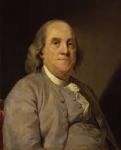
Benjamin Franklin
New England whalers in the 1700s mapped the Gulf Stream by following the migration of whales, dropping thermometers at intervals, noting the pace of the whale’s air bubbles, and the change in color of the water. They discovered that the mammals moved quicker when crossing the Gulf Stream rather than trying to swim against its current. When Benjamin Franklin heard about this, he tested the theory himself, found it accurate, and kept it secret from the British. By avoiding sailing against the Gulf Stream, American and French ships were able to cross the Atlantic at far greater speeds than the British, thereby gaining an advantage in the Revolutionary War.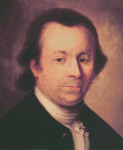
Button Gwinnett
We think we know about all the great men who signed the Declaration of Independence, but who the heck ever heard of Button Gwinnett? Born in Gloucestershire, England, in 1735, Gwinnett became a merchant in Bristol but eventually emigrated to Charleston, SC, and thence on to Savannah, GA. Appointed to the Continental Congress, he was one of the signers of the Declaration of Independence. Unfortunately, his personality was such that he was vengeful and embittered over an argument with a fellow gentlemen back in Georgia. This eventually led to a duel, and Gwinnett died from his wounds in 1777. His signature is so rare and highly sought that one sold in a 2010 Sotheby’s auction for $722,500.
The White House
The outside of The White House is pretty much imprinted on Americans’ brains. We see it in news articles, television news and in programs like ‘The West Wing’ or ‘Scandal’. But how much do we actually know about its construction? The capital was moved from Philadelphia in November, 1800, and the original name for Washington, D.C. was Federal City, D.C., changed to honor the first President. The design of the city was made by Pierre Charles L’Enfant and included a palace for the President, some five times its present size, with terraces, fountains and gardens. President Washington fired the architect and a competition for a design was held, the winner being James Hoban. Originally grey, the house was unlike what we know today. The British torched the residence during The War of 1812 and, although the mansion was rebuilt in 1817, new plans were drawn up to include the north and south porticos. The White House as seen today was completed in 1828.
Treaty of Guadalupe Hidalgo
On February 2, 1848, President Polk’s envoy concluded nine months of negotiations with the Mexicans subsequent to the Mexican-American War. In the Treaty of Guadalupe Hidalgo, he got the Mexicans to accept $15 million for what is now CA, NV,AZ, NM, UT, and parts of CO and WY. The timing could not have been better: on January 24th, 1848, gold had been discovered in California. Had the Mexicans known…
Mary Todd Lincoln dressed for her husband’s inauguration
We think we know a great deal about Abraham Lincoln, his wisdom and his leadership in preserving the Union. But his problems with his wife are only recently being discussed: a true shopaholic, she used his $25,000 salary to pay her outstanding equivalent clothing bill, and bought a $2000 dress for his inauguration along with a $600 parure of seed pearls.
 Most of us learn that standard time was initiated by the need of the railway system. When people changed from traveling an average of 4.8 miles an hour on horseback to sixty miles per hour on train, some form of standardization became vital. The United States east to west could have as many as three hundred time zones. For instance, before standardization, Philadelphia was some five minutes behind NYC and five minutes earlier than Baltimore. Great Britain had started setting standard time in 1847. But it was a Canadian who instigated the General Time Convention in 1883, suggesting that the world be divided into twenty-four time zones separated by one hour, fifteen degrees longitude apart. On November 18, the US railway timetables took up this standardization in a ‘Day of Two Noons.’ Eventually, the idea was taken up by large cities, and, finally, in 1918, Congress passed the Standard Time Act.
Most of us learn that standard time was initiated by the need of the railway system. When people changed from traveling an average of 4.8 miles an hour on horseback to sixty miles per hour on train, some form of standardization became vital. The United States east to west could have as many as three hundred time zones. For instance, before standardization, Philadelphia was some five minutes behind NYC and five minutes earlier than Baltimore. Great Britain had started setting standard time in 1847. But it was a Canadian who instigated the General Time Convention in 1883, suggesting that the world be divided into twenty-four time zones separated by one hour, fifteen degrees longitude apart. On November 18, the US railway timetables took up this standardization in a ‘Day of Two Noons.’ Eventually, the idea was taken up by large cities, and, finally, in 1918, Congress passed the Standard Time Act.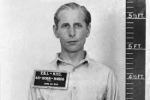
George John Dasch
Although not old enough to have been around during World War II, it was certainly in my education that America had been safe from German invasion because of the distance from the European theatre of war. Not actually so! In 1942, the Germans prompted Operation Pastorius, landing eight saboteurs from two submarines, one in Ponte Vedra Beach, FL, and the other in Amagansett, Long Island, New York. Their mission was to blow up railways, industrial plants, Jewish businesses, and so on, and they came prepared with explosives, detonators and other necessary items—including money to spend. Chosen by the Germans for their ability to speak good English and their past experience in the United States, Hitler’s government never thought the men might try to defect. With one man having served time in a concentration camp and others with loyalties to America, the leader, George John Dasch, reported the group to the FBI. Unfortunately for him, turning State’s evidence did not help him. Of the eight men, six were executed, and Dasch and one other received lengthy prison sentences.
US Constitution
I’d like to end on one small fact that may be of interest to all my fellow authors. The only ‘right’ granted in the Constitution of the United States, Article 1, Section 8, gives Congress power to “promote the Progress of Science and useful Arts, by securing for limited Times to Authors and Inventors the exclusive Right to their respective Writings and Discoveries.” It was written in 1789, three years prior to The Bill of Rights.
Some of this information was brought to my attention in American History Revised: 200 Startling Facts that never made it into the textbooks by Seymour Morris, Jr. ( Broadway Books, New York, 2010) Although the book has, by my humble reckoning, a number of discrepancies, it is certainly well worth the read and highly entertaining.
All photos public domain

February 28, 2015
WHY YOU DO IT
This month I’m taking ‘medical leave’ and handing over to a guest I’ve known for thirty-one years: my daughter, Cristal. Since I’m an extremely proud mother, I could write a couple of pages on her brilliant achievements but I’ll spare you that. It’s sufficient to say that Cristal holds two Masters degrees, and currently works in Bogota, Colombia, for the International Organization for Migration, a branch of the UN. As she’s always been considered somewhat un-athletic (her swimming instructor called her “spaghetti legs”), I was obviously surprised when she took up running. When I asked her why, this was her response…
 Running: the final frontier. Or perhaps I should say that writing about running is the final frontier, as I’ve never written about anything athletic in my life and much less about running, which I only took up six months ago!
Running: the final frontier. Or perhaps I should say that writing about running is the final frontier, as I’ve never written about anything athletic in my life and much less about running, which I only took up six months ago!
I was visiting my mother in New York in October, 2014, and wanted to make sure that I got some exercise while I was there. We are lucky enough to live close to Central Park, so it seemed the obvious choice in terms of location. I had tried running a few times, some years ago, with little success – I never made it around the Jackie Onassis Reservoir (2.5 kilometers), and got bored quite quickly. This time, however, I decided to really give it my all. There were two reasons why. The main reason was that I had signed up for a 10k race to support UNICEF, in Colombia, in November, and I knew I wouldn’t be able to do it without some kind of training in addition to the short aerobic workouts I’d been doing at home in the months prior.

February 2, 2015
What I Know About Texas
When I was growing up in the suburbs outside of New York, what I knew about Texas would just about have fit on a pin head. Under the age of ten, I could probably sing ‘She’s the Yellow Rose of Texas’ and ‘Deep in the Heart of Texas,’ having some vague idea that Texas was called ‘The Lone Star State.’ Aside from that, I knew it was somewhere ‘out there’ in the middle of the country, was the largest state in the union as was then, and that, for some reason, everything in Texas was big. The mind boggled. Around the age of ten I learned there was something called The Texas Rangers but had no idea who they were, and also that all the men wore cowboy hats. I was aware that Texas was the center of the American oil industry, and that there was a family named King who owned the largest ranch in the United States. And then there was Davy Crockett, Jim Bowie and The Alamo, and eventually Willie Nelson and Waylon Jennings singing about Luckenbach, Texas—wherever that might be. Oh, and bluebonnets grow there.
There’s no rhyme or reason to why certain facts filter through, whatever the truth behind them, and others do not, and I have no real idea when the true facts about Texas started to fall into place. In school, history is a general sweep of The United States and perhaps a touch on your home state. My first trip to Texas was when I was aged fifteen with a bunch of fellow high school kids, most of them older than I who had skipped a grade, all bound for college the following year. The trip included El Paso and Houston, and I recall the boys were all terribly…well…naughty, for want of a better word. After that, there were brief visits from London to Dallas, en route to a ranch in Tucson, and a visit to friends living in Richardson, TX. The one memory I have about that stay is being put in a chokehold by a woman in a department store trying to sell me cosmetics.
However, Texas retained its exotic status in my brain despite these unfortunate interludes. I knew Dallas and Houston were hardly representative of a state that could swallow a huge chunk of Europe, never mind several east coast states. The 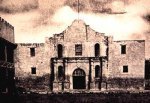 Alamo was a symbol of fortitude and courage; not only had Crockett and Bowie made their mark but elsewhere Sam Houston and Stephen Austin were helping to shape what would become the twenty-eighth state. But there was no historical reason why I would choose Texas as the main setting for my contemporary novel; I was entranced by the Texas Two-Step, and ideas sprang from that. In beginning to write, research, as it often does, uncovered new facts, some of which, I dare say, even Texans may not be aware of. Here are some interesting facts related to Texas I uncovered:
Alamo was a symbol of fortitude and courage; not only had Crockett and Bowie made their mark but elsewhere Sam Houston and Stephen Austin were helping to shape what would become the twenty-eighth state. But there was no historical reason why I would choose Texas as the main setting for my contemporary novel; I was entranced by the Texas Two-Step, and ideas sprang from that. In beginning to write, research, as it often does, uncovered new facts, some of which, I dare say, even Texans may not be aware of. Here are some interesting facts related to Texas I uncovered:
Alexander Hamilton, a Founding Father, drew up a plan to take over Mexico, which, of course, would have included the area known as Texas. Then-President John Adams nixed the plan. It wasn’t until 1846 that Texas was finally admitted to the Union—a full ten years after gaining independence from Mexico.
Karl Marx and Frederich Engels believed that all of Mexico, then including Texas, should be placed in the hands of the United States. After Texas won independence from Mexico, the very diplomatic President Martin Van Buren (President 1837-1841) decided on Texas remaining autonomous, which it did from 1836-1846. It was President Polk ( President 1845-1849) who agreed to admit Texas to the Union.
The boundaries of Texas originally included half of what is today New Mexico, about a third of present Colorado, plus bits of Kansas, Oklahoma and Wyoming. The extra bits were given up in exchange for the US Federal Government assuming Texas’ debts.
Galveston, the major port of Texas, was called ‘The New York of the Gulf’ and was once more prosperous than Dallas or Houston, and had more millionaires than Newport, RI. The hurricane of 1900 killed more than 20% of the population, some six thousand people, far more than Katrina. And…
Only two Presidents were Texans by birth. Can you name them without Googling?
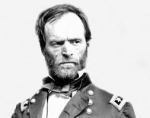
General Philip Henry Sheridan
With this hodge-podge of information, how did I end up with Texas as the setting for my book? Civil War General Philip Henry Sheridan said, “If I owned Texas and Hell, I would rent out Texas and live in Hell.” As I sit here dealing with the remnants of a northeast blizzard, a little bit of Texas’ heat would do me fine. But the appeal isn’t in its climate. What I know about Texas is this: the climate is pretty unbearable in the summer months, and I don’t think I could survive; the geography is varied and encapsulates a good variety of much of the United States; there are dance halls 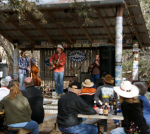 and honky tonks that go back to the nineteenth century and I’d like to visit them all; and the people are, for the most part, proud, big-hearted, warm and welcoming. That may not be a lot to go on, but that’s what I know about Texas.
and honky tonks that go back to the nineteenth century and I’d like to visit them all; and the people are, for the most part, proud, big-hearted, warm and welcoming. That may not be a lot to go on, but that’s what I know about Texas.
If you can startle me with an interesting fact about Texas, you might win a copy of Dances of the Heart. Go ahead and try. There’s plenty of facts out there. The facts I garnered above came from:
American History Revised: 200 Startling Facts. Morris Jr., Seymour. Broadway Books, New York.
Photos above : first two and the last, courtesy of Karen Casey Fitzjerrell; fifth, courtesy of Cristal Downing; remaining historical photos in public domain
***********************************************************************
Successful, workaholic author Carrie Bennett lives through her writing, but can’t succeed at writing a man into her life. Furthermore, her equally successful but cynical daughter, Paige, proves inconsolable after the death of her fiancé.
Hard-drinking rancher Ray Ryder can find humor in just about anything—except the loss of his oldest son. His younger son, Jake, recently returned from Iraq, now keeps a secret that could shatter his deceased brother’s good name.
On one sultry night in Texas, relationships blossom when the four meet, starting a series of events that move from the dancehalls of Hill Country to the beach parties of East Hampton, and from the penthouses of New York to the backstreets of a Mexican border town. But the hurts of the past are hard to leave behind, especially when old adversaries threaten the fragile ties that bind family to family…and lover to lover.
Available from February 4th wherever ebooks are sold, including:
The Wild Rose Press: http://www.wildrosepublishing.com/maincatalog_v151/index.php?main_page=index&manufacturers_id=991







